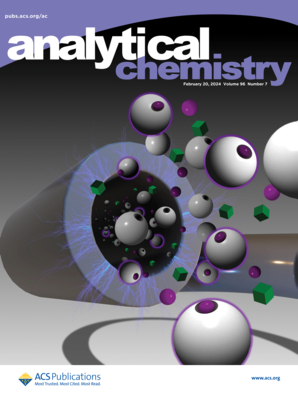Novel Charge-Switch Derivatization Method Using 3-(Chlorosulfonyl)benzoic Acid for Sensitive RP-UHPLC/MS/MS Analysis of Acylglycerols, Sterols, and Prenols
IF 6.7
1区 化学
Q1 CHEMISTRY, ANALYTICAL
引用次数: 0
Abstract
Chemical derivatization involves the reaction of an analyte with a derivatization agent to modify its structure, improving the peak shape, chromatographic performance, structural analysis, ionization efficiency, and sensitivity. A novel derivatization method using 3-(chlorosulfonyl)benzoic acid is developed for the determination of monoacylglycerols, diacylglycerols, free sterols, and tocopherols using the reversed-phase ultra-high-performance liquid chromatography–tandem mass spectrometry (RP-UHPLC/MS/MS) method in the negative ion mode. The chromatographic and mass spectrometric properties of derivatized lipids are investigated by using 29 lipid standards spanning four lipid classes. The derivatization process is optimized using pooled plasma spiked by 9 internal standards, achieving an optimal yield with a reaction time of 40 min at 60 °C. The stability of the derivatives is confirmed, with short-term stability maintained for 10 h at 4 °C and long-term stability preserved for 5 days at −80 °C. The repeatability and reproducibility are verified by one/two operator(s), which underscores the simplicity and robustness of the method, and calibration curves with high linear regression coefficients illustrate the accuracy of the method. The derivatization approach, which combines RP-UHPLC/MS/MS and the use of specific fragmentation patterns, significantly reduces limits of detection, reaching 15–25 pmol/mL for free sterols in plasma. The optimized method is applied to the analysis of human plasma, leading to the identification of 92 lipid species in the targeted lipid classes. This represents a substantial improvement in sensitivity and detection capabilities compared to those of previously reported methods.

求助全文
约1分钟内获得全文
求助全文
来源期刊

Analytical Chemistry
化学-分析化学
CiteScore
12.10
自引率
12.20%
发文量
1949
审稿时长
1.4 months
期刊介绍:
Analytical Chemistry, a peer-reviewed research journal, focuses on disseminating new and original knowledge across all branches of analytical chemistry. Fundamental articles may explore general principles of chemical measurement science and need not directly address existing or potential analytical methodology. They can be entirely theoretical or report experimental results. Contributions may cover various phases of analytical operations, including sampling, bioanalysis, electrochemistry, mass spectrometry, microscale and nanoscale systems, environmental analysis, separations, spectroscopy, chemical reactions and selectivity, instrumentation, imaging, surface analysis, and data processing. Papers discussing known analytical methods should present a significant, original application of the method, a notable improvement, or results on an important analyte.
 求助内容:
求助内容: 应助结果提醒方式:
应助结果提醒方式:


